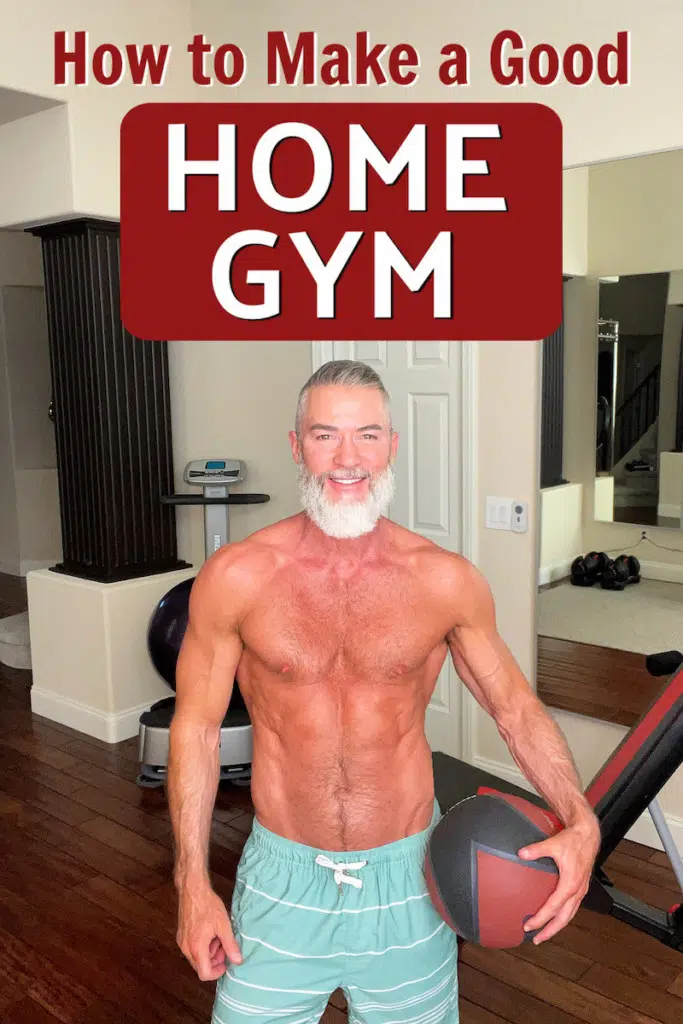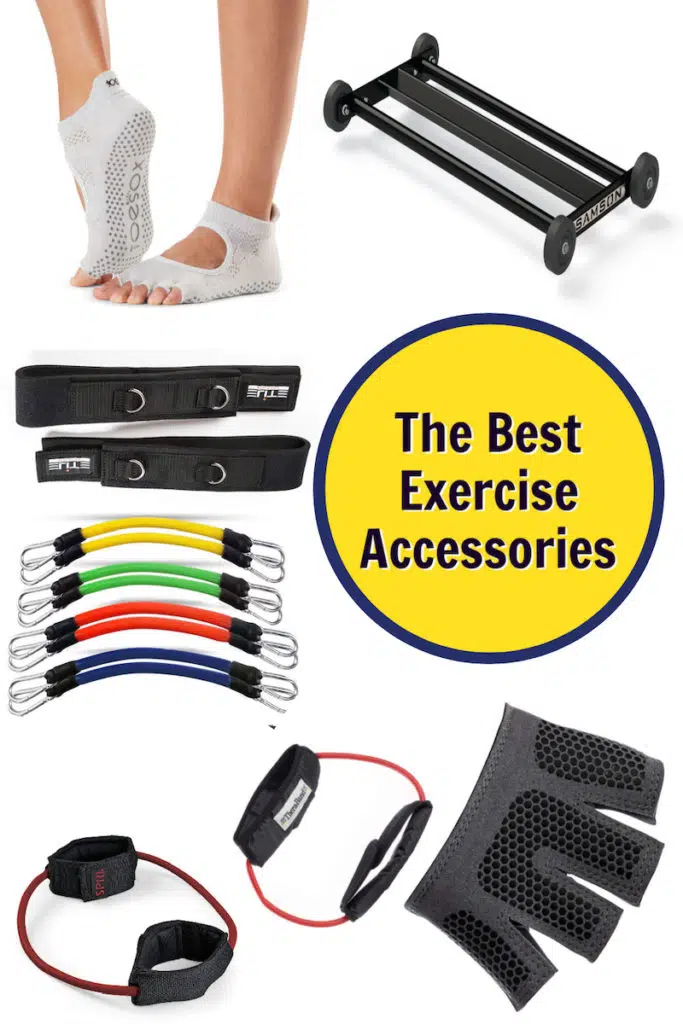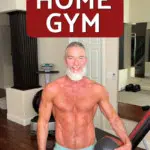Here are home gym ideas for every budget – including tips for configuring your home gym area to match your unique needs and workout style.
I’ve also included a full-body workout video using exercise accessories that are well-suited for a home gym.
Toward the end of the video, I provide a quick tour of my home gym with an explanation (set the video player’s sound to on) of what tools you can use within your home’s fitness area.
Benefits of a Home Gym
Have you ever wanted to avoid a crowded, smelly gym or wondered what it would be like to have a great home gym instead?
You can create an excellent home gym with the right exercise accessories – whether it’s within a corner of your studio apartment, an entire guest room in your house, or even a garage, basement, or backyard patio.
When you designate a specific area within your home for fitness, your health can improve, and life can become more enjoyable.
In fact, I often have a better workout in my home gym than I do at the commercial gym.
Even though a commercial gym has machines I don’t have at home, the equipment I do have at home is highly effective. Plus, at home, I don’t have to negotiate crowds or wait for any equipment to become available.

Your home gym will likely be cleaner and more organized than any commercial gym, and once you get started on your home workout, it’s easier to stay focused and avoid distraction.
Since time is truly your most valuable resource, you’ll likely enjoy not having to commute to and from a commercial gym. A home gym will use your limited time much more effectively, and you’ll even save on fuel costs.
In an earlier article, I outlined how you could easily create a mobile circuit-training gym by keeping specific types of fitness equipment inside a canvas crate within the trunk of your car.
I do this myself and enjoy working out in my neighborhood parks – usually between three to eight times a month.
But I also enjoy exercising at home. In my particular case, I turned my entire living room into a gym (I’m not suggesting everyone do that; I’m just eccentric that way).
Additionally, I put a fitness-friendly astroturf in my backyard so I could exercise there. And I’ve even been known to workout in my driveway.
Of course, many people would find this arrangement a bit extreme, so I’m providing you with several other home gym scenarios that might work better for you.
Downsides to Exercising at Home
The hardest part of working out in your home gym is simply getting started (when you arrive at a commercial gym, sometimes the environment will provide you with a bit of external motivation that makes beginning exercises a tad easier).
However, once you actually begin the workout, I believe it’s easier to keep going in a home gym because there are fewer weird distractions.
How to Build a Home Gym
Allow me to give you this vital tip. Once you set up your home gym area, keep it pristine:
- Do not fill the area with clutter.
- Do not set boxes on your treadmill or drape laundry over your bike.
- The more seriously you take your home gym, the more hours of joy and meaning it will provide you.
Mini Gym at Home Ideas
Here are gym exercise accessories for those with an entry-level budget or those with limited space.
The least expensive equipment you can put inside your home gym area is a selection of resistance bands.
Bands are comparatively cheap and surprisingly effective. I’m a big fan of resistance bands; they have helped strengthen and define my physique in a way that other fitness equipment can’t quite achieve. This is probably because the bands help you emphasize the eccentric phase of a muscular contraction.
For the most simple and affordable home gym setup, you will need:
- a selection of resistance bands
- a textured rubber mat (unless your gym area is carpeted or matted already)
- a non-slip, microfiber towel that matches the size of your mat
- a kettlebell (get one that is a bit heavier than you’d like)
- stationary recumbent bike
You can have a fantastic workout with your mat, towel, resistance bands, and kettlebell. Use any of my workout videos as a jumping-off point.
Home Gym Equipment Recommendations for an Intermediate-Level Budget
If you can swing it, you might also want a stationary recumbent bike or elliptical machine for your home gym area.
Though on fair-weather days, you can always walk or run outdoors, on days when the weather is less than perfect, you’ll find a recumbent bike or elliptical comes in very handy. You can perhaps find a used one at a discounted price on a local list site such as Craigslist.
The rest of the suggested equipment is optional. You don’t need anything beyond the five items I’ve already listed for the entry-level budget, plus a bike or elliptical. However, if you have more to spend in your budget, the next level up would be to get:
- a pair of adjustable dumbbells
- an adjustable bench
- suspension straps
- stability ball
For my adjustable dumbbells, I use Bowflex (see video). They are excellent, in my opinion.
For your adjustable bench, find one with a decline setting, a flat setting, and (preferably) five incline settings. Do your research before purchasing your bench. The more settings it has, probably the better the bench will serve you. On the other hand, you want it to be portable.
You might also consider getting suspension straps like TRX for your home gym.
One big benefit to straps is that they make it easier to train the torso’s posterior chain of muscles – rear delts, lats, and rhomboids. Most straps contain an attachment that you slip over a door before closing. This is helpful because not everyone has a pull-up bar (assuming one is even strong enough to do pull-ups).
Showstoppers for the Luxury Home Gym
Finally, if you’re an enthusiast like me, you’ll want space to place your not-necessary but fun-to-have pieces. In my case, that includes a vibe plate and my Pilates equipment:
- trapeze table
- reformer
- Wunda chair
Alternatively, for weight training, you might consider a complete gym system – perhaps something that has cables. Or, perhaps a barbell, some plates, and a landmine.
But please don’t be put off by my elaborate set-up. Again, all you really need are 4 or 5 basics, and that requires little space and the least amount of money.
Home Gym Set-Up Ideas
As time passes, you’ll likely begin to acquire a collection of various workout toys. You’re going to need a designated place to keep that stuff.
Consider placing cubbyhole shelving units in the room corner (see video). This way, each cubby represents a fitness tool category. I have mine divided up into:
- fitness books
- mobility tools – lacrosse balls, rollers, etc.
- glute tools
- weight training – push-up platforms, weighted balls, weighted vest, grip strengtheners, etc.
- gloves
- fitness DVDs
- massage guns
- neck tools
- swimming
- resistance bands
- maintenance
I also have a large stability ball and vertical cardio climbing machine.
Home Gym Ideas for Your Garage
Garage gyms are increasingly popular, which I think is great. However, my viewpoint is that a garage is, firstly, for the car. I have often seen houses with messy garages that are strewn with $4,000 worth of junk and clutter; meanwhile, the $80,000 car sits on the driveway or in the street, getting baked in the sun or rusted in the snow.
That makes no sense to me.
Automobiles are often the biggest family investment (or next-biggest if they also have a house mortgage), so it makes sense to protect that investment and use the garage as it was designed – for the car.
Fortunately, they now make power weight-training racks that are collapsable.
Usually, they are squat racks with pull-up bars and accessories – such as a bench or dipping handles – that are foldable and only take up four inches of space when not in use.
That means you can back your car out of the garage, then workout, and return the car when you’re finished.
Considerations for a Basement Home Gym
The tips provided for a garage gym also apply to a basement gym. However, with a basement gym, you also want to be mindful of proper air circulation. Also, keep the ceiling height in mind if you’re purchasing basement gym equipment. You want some extra space between where the top of your equipment ends and where your ceiling begins.
Example of a Home Gym Workout
Try this workout at home (refer to video). Modify the exercises to match your circumstances. Beginners can use lighter weight and do two sets of each exercise (12 reps each set). Intermediate-level athletes can do three sets. Advanced exercisers can go significantly heavier on their final, third set:
- Reverse Dumbell Lunges for Thighs and Glutes
- Single-Leg Heel Raises for Calves
- Single Leg Pull for Abs
- Double Leg Pull for Abs
- Alternating Straight-Leg Double Pulse for Abs
- Subtle Pelvic Scoops for Abs
- Slow Bicycle for Core
- Single-Leg Box Step-Up with Kettlebell for Lower Body and Core
- Cable Fly from Underneath (with cables, springs, or bands) for Pecs
- Single-Arm Dumbbell Row for Lats and Rhomboids
- Tricep Dips (using handles or benches)
- Kettlebell Pull-Over for Torso
- Reverse Fly with Band for Posterior Deltoids
- Dumbbell Shoulder Press
TIP: when doing Kettlebell Pull-Overs, the hips should be slightly lower than the bench. Rest your neck on the bench. Keep your navel pulled in tightly, and your glutes should remain activated to help protect your lower back.
TIP: for Dumbbell Shoulder Press, ensure your first set is light to help warm up the shoulder joints.
As always, proceed cautiously and obtain your doctor’s approval before making any significant changes to your movement regimen.
Bonus Exercise Accessories for Your Home Gym
Exercise accessories are those additional fitness tools that help make your workouts even more effective and enjoyable.

As mentioned earlier, I keep my home gym and car both stocked with exercise accessories.
During a typical week, there are several different locations at which I workout:
- in my neighborhood gym
- in my home gym
- at local fitness parks (I live in the desert, so I can workout outdoors throughout the year).
I find it helpful and motivating to keep an ample supply of exercise accessories for all these workouts.
I share ideas and inspiration online – in photos and videos featured on Pinterest and this website – and, over time, I’ve noticed that there are four specific exercise accessories that I get asked about almost every time they appear.
I’m sharing these products in case you find them helpful.
For the record, I’m not affiliated with the companies that make these items, and I don’t participate in any revenue from their sale.
1. Barehand Partial Gloves
In the culture of CrossFit, it’s considered cool to build up very thick hand calluses. However, when calluses get too thick, they tear easily during pull-ups or barbell work – exposing small, pink openings that become a simple way for staphylococcus pathogens to enter your body.
Open skin tears and staph infections are not cool, folks.
Also, that hardened skin on your palms might not bother you much but probably doesn’t feel great to your romantic partner when touched by you – the edges of calluses can get textured and sharp.
Using gloves while exercising helps to secure your grip (particularly if your palms become a bit sweaty during intense exertion) and prevent callus build-up on the pads at the base of your fingers.
Some people wear full gloves that cover the entire hand, including fingers; however, this extra padding over-corrects the problem by making the skin too soft and unresponsive (the nerve endings at the tips of your fingers are highly sensitive and responsible for sending sensory information to your brain).
Barehand is a brand of partial gloves that protect the pads at the base of your fingers while leaving the heels of your palms and fingertips exposed.
For me, they have been a game-changer.
Other brands of partial gloves are less expensive (find them on Amazon). However, I pay a bit more for the Barehand brand because I can throw them in the laundry machine over and over. They’re so well constructed that they don’t fall apart after multiple washes. Once or twice a year, Barehand usually offers a 40% off sale.
2. Resistance Bands with Padded Cuffs
Everyone knows about both open and looped resistance bands, but not everyone knows about the bands with padded cuffs. The padded cuffs allow for a whole other menu of possible exercises.
Even today, I’m still surprised that people don’t use resistance bands more often. They’re effective, versatile, and affordable.
Some brands currently available with padded cuffs include Spri, TheraBand, and Elite Supplies.
3. Glute Ham Roller for Your Home Gym
The exercise accessories in this list are all made by different manufacturers, and the Glute Ham Roller is made by a company called Samson Equipment. Use this roller to do a variety of bridge thrusts and reverse hamstring curls – also push-ups, lunges, and more.
The Glute Ham Roller is in no way essential to a good workout. It’s just an extra tool that can add some fun variety and spice to your workouts. I imagine it might also be handy if you have to move a sofa!
4. Toe Sox
Your feet form the foundation upon which the rest of your body is built. For this reason, it’s important to have healthy, strong, and supple feet.
The principle behind Toe Sox is the same as is behind the Barehand Partial Gloves (see above) – better grip and absorption.
I’m a big believer in working out barefoot – particularly for yoga and pilates – but sometimes you need a little arch support, protection, and non-slip texture while still exposing your heel and toes.
Because of the 20 muscles in the human foot, toes are like little suction cups that help you to both propel and stay grounded (if you’ve ever seen a monkey move around and climb trees, you know what I’m talking about).
Standard socks and shoes squish the toes together, which is disadvantageous.
Another benefit to Toe Sox is that they help create a little extra separation between your toes.
Conclusion about Exercise Accessories for Your New Home Gym
- If you have a small budget, invest in some basic equipment like resistance bands, a good mat, and a non-slip yoga towel.
- If you have more to spend, consider purchasing an elliptical, a weight bench, and some adjustable dumbbells.
- Consider purchasing a complete gym system or Pilates apparatus for a luxury home gym.
- For a basement gym, be mindful of proper air circulation and consider ceiling height when purchasing new equipment.
- For a garage gym, consider one of the new collapsable power racks.
- Use vertical storage solutions for your equipment to make the most of whatever space you have.
- Create an inspiring workout area with well-considered lighting and thoughtful design.
- Stock up on healthier snacks and workout drinks to keep you fueled throughout your exercise session.
Exercising for people over 50 is different from working out in your twenties.
As a young person, you get energized by the crowds and have a lower risk of serious injury. Over 50, however, extra precautions are wise.
The ability to focus better in a home gym – and the convenience of not having to spend time and energy traveling to a commercial gym – is highly beneficial to the mature athlete. Home gyms can make it easier to achieve new fitness goals and improve mobility.
